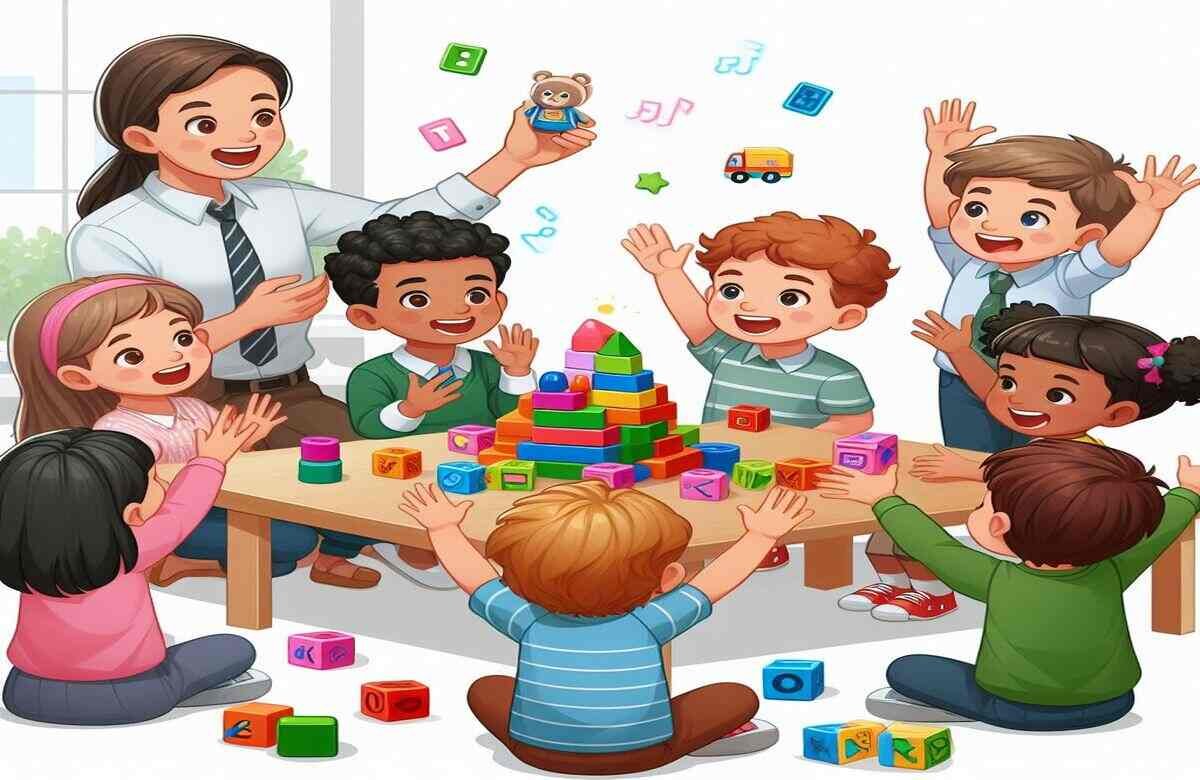Occupational therapy (OT) is a unique and specialized form of therapy that helps children with physical, sensory, or cognitive disabilities overcome challenges in everyday activities.
Whether it’s tying their shoes, brushing their teeth, or playing games, OT focuses on tasks that children may struggle with due to their condition. In addition, occupational therapy also assists children in developing learning strategies to stay focused in school, promoting their independence, and supporting them in leading fulfilling lives.
When it comes to explaining occupational therapy to children, it’s essential to use a child-friendly approach that simplifies the concept. By presenting OT in a manner that resonates with their understanding, children can grasp its importance and how it can assist them. Let’s explore occupational therapy in a way that children can easily relate to and appreciate.
Key Takeaways:
- Occupational therapy helps children with disabilities perform everyday activities.
- OT focuses on tasks like dressing, feeding, and participating fully in school.
- Children with autism can benefit from occupational therapy for learning social skills.
- The duration of occupational therapy treatment varies for each child.
- OT sessions are designed to be engaging and enjoyable for children.
How Occupational Therapy Benefits Children:
- Enhances fine and gross motor skills
- Improves sensory processing and integration
- Promotes self-regulation and emotional well-being
- Fosters social interactions and communication
- Builds independence in daily activities
Occupational therapy is not limited to specific conditions or age groups. It can benefit children with a wide range of challenges, such as developmental delays, learning disabilities, ADHD, or physical disabilities. By addressing the unique needs of each child, occupational therapists help them overcome obstacles and reach their full potential.
| Key Benefits of Child-Friendly Occupational Therapy | Why Occupational Therapy is Essential for Kids |
|---|---|
| 1. Promotes independence and functional skills | 1. Helps children with disabilities lead fulfilling lives |
| 2. Enhances cognitive and academic abilities | 2. Improves attention, concentration, and learning strategies |
| 3. Supports emotional well-being and self-confidence | 3. Provides a safe and supportive environment for growth |
| 4. Develops social skills and peer interactions | 4. Assists children with autism in learning social skills |
| 5. Helps with sensory processing and regulation | 5. Supports children with sensory processing challenges |
Who needs occupational therapy?
Occupational therapy (OT) is beneficial for many children who face challenges in their daily activities. Whether it’s struggling with tasks like writing, drawing, or paying attention, or using a wheelchair to navigate the school environment, occupational therapy can provide valuable support and guidance for children of all abilities.
Children with autism may require additional strategies to help them interact with others, and occupational therapy can play a crucial role in facilitating their social development. By addressing their specific needs through OT, children with autism can gain the necessary skills and confidence to engage actively in social situations.
Occupational therapy also focuses on helping children build the necessary skills to participate fully in activities that are essential for personal growth. OT sessions often involve engaging and interactive exercises, customized to suit each child’s interests and goals. Through these activities, occupational therapists create a fun and supportive environment where children can enhance their motor skills, social skills, and emotional regulation.
Examples of Activities in Occupational Therapy
| Activity | Description |
|---|---|
| Gross Motor Skills Activities | These activities focus on improving coordination, balance, and overall physical strength. Examples include jumping, catching, kicking, swinging, and climbing. |
| Fine Motor Skills Activities | These activities aim to enhance small muscle control and dexterity. Examples include coloring, cutting, stacking blocks, threading beads, and manipulating small objects. |
| Sensory Integration Activities | These activities help children regulate their sensory responses and improve sensory processing. Examples include finger painting, playing with textured materials, and engaging in swinging or spinning exercises. |
| Social Skills Activities | These activities focus on developing social interaction and communication skills, such as turn-taking, sharing, listening, and following instructions. |
| Self-Care Activities | These activities promote independence and self-care skills, including dressing, grooming, brushing teeth, tying shoelaces, and feeding oneself. |
Occupational therapy provides children with the tools they need to overcome challenges and thrive in their daily lives. By explaining the benefits of OT to children in a child-friendly manner, we can help them understand and appreciate the valuable support occupational therapy offers. Through engaging activities and guidance from skilled occupational therapists, children can develop the skills necessary to lead fulfilling and independent lives.
How long does occupational therapy treatment last?

The duration of occupational therapy treatment varies for each child. It depends on their unique needs and abilities. Some children may require short-term intervention, while others may need ongoing support throughout their childhood. Treatment can be adjusted as the child grows and faces new challenges. It is important for children to follow the instructions of their occupational therapist, practice activities at home, and actively participate in their treatment.
By introducing occupational therapy to children in a child-friendly manner, we can help them understand and appreciate the benefits of this therapy. Encouraging their active involvement in their treatment can foster a sense of responsibility and empowerment. It is a collaborative process where the child and therapist work together to set goals, track progress, and make adjustments as needed.
“Occupational therapy treatment duration is tailored to each child’s specific needs and progress. It is not a one-size-fits-all approach but a personalized journey towards independence and enhanced abilities.”
Occupational therapy is a dynamic process, and the length of treatment can vary. Regular evaluation and communication with the occupational therapist are essential to ensuring that the therapy is meeting the child’s needs effectively. Through ongoing assessment and discussions, the therapist can determine if adjustments need to be made in the treatment plan or if additional interventions are required.
Ultimately, occupational therapy aims to equip children with the skills and strategies they need to overcome challenges and thrive in their daily activities. It is a collaborative partnership between the child, their family, and the occupational therapist, with the goal of promoting independence, enhancing abilities, and improving overall quality of life.
| Child’s Need | Treatment Duration |
|---|---|
| Short-Term Intervention | Varies, typically a few weeks to a few months |
| Ongoing Support | Variations can extend throughout childhood |
| Reevaluation and Adjustments | Regularly, based on progress and needs |
Making Occupational Therapy Fun and Engaging
Occupational therapy sessions are designed to be engaging and enjoyable for kids. Therapists understand that children learn best through play, so they incorporate games, play, and activities into the therapy sessions.
By tailoring the activities to each child’s goals and interests, occupational therapists create a stimulating and interactive environment. This helps children stay motivated and eager to participate in the therapy process.
Through play-based interventions, occupational therapists help children improve their motor skills, social skills, and emotional regulation in a fun and child-friendly way. By focusing on activities that children enjoy, therapy becomes a positive and rewarding experience.
For example, a child who is working on fine motor skills might engage in painting, coloring, or playing with manipulative toys. These activities not only enhance their motor skills but also stimulate creativity and self-expression.
In group therapy sessions, children have the opportunity to socialize, make friends, and learn how to interact with others. By incorporating cooperative games and team-building activities, occupational therapists promote social skills development.
Benefits of Child-Friendly Occupational Therapy:
- Improvement in fine motor skills
- Enhancement of gross motor skills
- Development of social skills
- Promotion of self-confidence and self-esteem
- Improved attention and focus
- Regulation of emotions and behaviors
Occupational therapy sessions not only help children overcome challenges but also provide them with opportunities to explore their abilities, build resilience, and achieve their full potential.
“Occupational therapy allows children to grow and thrive in a playful and supportive environment, empowering them to become independent and confident individuals.”
Conclusion
Occupational therapy is a valuable resource for kids facing disabilities or challenges. It plays a crucial role in helping them overcome barriers and gain independence in their daily activities. By explaining occupational therapy to children in a child-friendly manner, we can enable them to grasp and appreciate its immense benefits. Occupational therapy is not just about performing tasks; it empowers children to reach their full potential and lead meaningful lives.
Through child-friendly occupational therapy, children with disabilities can develop essential skills for daily activities like dressing, eating, and playing. Occupational therapists create a fun and engaging environment, using games and activities tailored to each child’s specific goals and interests. They work closely with children, supporting their physical, cognitive, and emotional development and helping them build strong social connections.
Occupational therapy for kids embraces the belief that every child has unique talents and abilities. By providing the necessary tools and guidance, occupational therapists help children unleash their potential and discover new strengths. This therapy opens doors for children, enabling them to navigate the challenges they face confidently. As children engage in child-friendly occupational therapy, they not only learn new skills but also develop self-confidence, resilience, and a positive outlook on life.
FAQ
How can I explain occupational therapy to my child?
Occupational therapy is a form of therapy that helps kids with disabilities or challenges carry out everyday activities. It focuses on tasks like dressing, tying shoes, feeding themselves, and paying attention in class. The goal of occupational therapy is to help children be as independent as possible.
Who can benefit from occupational therapy?
Many children can benefit from occupational therapy. Kids who have difficulty with activities like writing, drawing, or paying attention may benefit from OT. Children who use wheelchairs can also receive support from occupational therapists to navigate the school environment and participate fully in activities. Children with autism may require strategies to help them interact with others, and occupational therapy can provide guidance in these areas.
How long does occupational therapy treatment last?
The duration of occupational therapy treatment varies for each child. It depends on their unique needs and abilities. Some children may require short-term intervention, while others may need ongoing support throughout their childhood. Treatment can be adjusted as the child grows and faces new challenges. It is important for children to follow the instructions of their occupational therapist, practice activities at home, and actively participate in their treatment.
How can occupational therapy be fun for kids?
Occupational therapy sessions are designed to be engaging and enjoyable for children. Therapists use games, play, and activities that are tailored to the child’s goals and interests. They create a safe and supportive environment where children can learn and develop new skills. Through play-based interventions, occupational therapists help children improve their motor skills, social skills, and emotional regulation in a fun and kid-friendly way.
What are the benefits of occupational therapy for kids?
Occupational therapy is a valuable resource for children with disabilities or challenges. It helps them overcome barriers and become more independent in their daily activities. By explaining occupational therapy to children in a child-friendly manner, we can help them understand and appreciate the benefits of this therapy. Occupational therapy empowers children to reach their full potential and lead meaningful lives.





